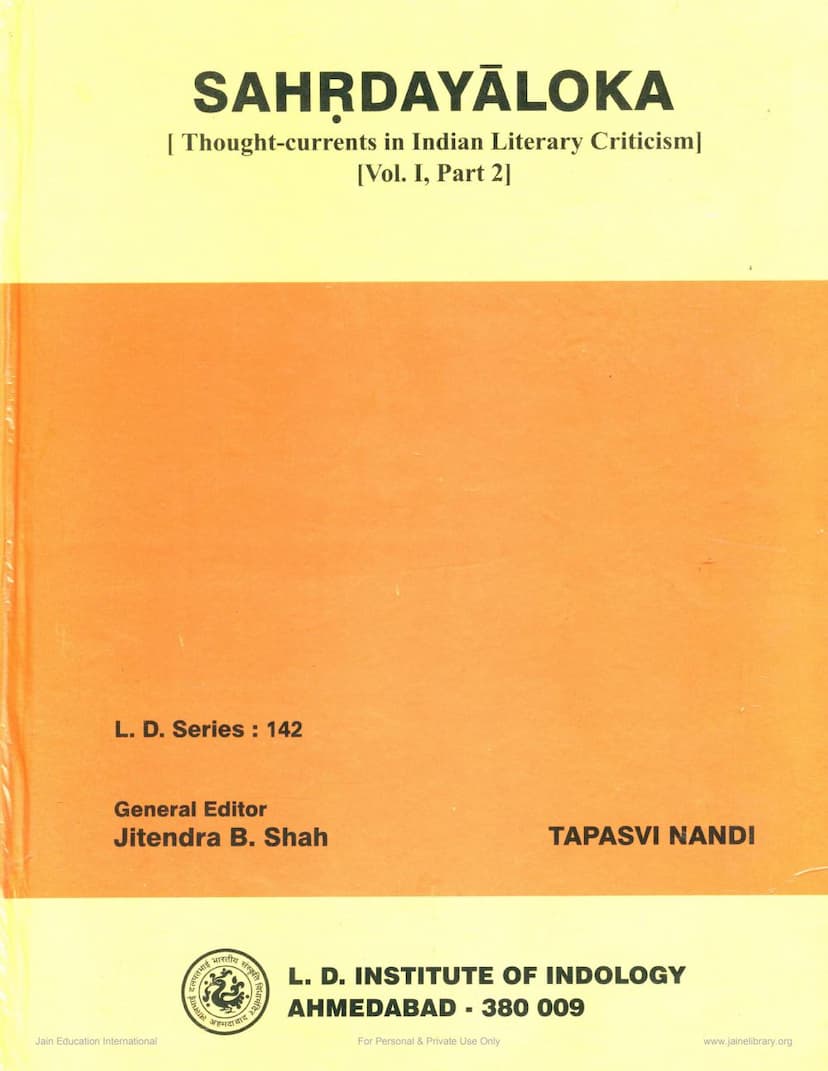Sahrdayaloka Part 02
Added to library: September 2, 2025

Summary
"Sahrdayaloka Part 02" by Tapasvi Nandi, published by L. D. Institute of Indology, Ahmedabad, is the second part of a larger work on "Thought-currents in Indian Literary Criticism." This volume delves deeply into the theoretical underpinnings of Sanskrit literary aesthetics, tracing the evolution and significance of key concepts.
The book begins by acknowledging its debt to predecessors and modern scholars in the field of Alamkāraśāstra (the science of literary embellishment and aesthetics). The author expresses gratitude to his teachers and the scholars whose works served as a foundation for his own research. He emphasizes a personal verification of sources and a respectful engagement with differing opinions, aiming for a historical, critical, and comparative perspective.
A significant aspect of the work is the author's effort to explain the relevance of classical Indian aesthetic thought, particularly the concepts of Dhvani (suggestion) and Rasa (aesthetic relish), to contemporary and even avant-garde literary forms, including absurd poetry and theatre.
The volume is structured into eighteen chapters, covering a wide range of topics within Indian literary criticism:
- Definition and Scope of Poetry: The initial chapters explore the fundamental questions of what constitutes poetry, its purpose (kāvya-hetu and kāvya-prayojana), and its scope.
- Word Functions (Śabda-vyāpāra): The text meticulously examines the different powers of words, including Abhidhā (direct meaning), Lakṣaṇā (indication), and Vyañjanā (suggestion). It traces their origins from Vedic literature and grammatical traditions (like those of Pāṇini and Patañjali) through the works of influential alamkārikas (rhetoricians) such as Bhāmaha, Dandin, Vāmana, Udbhata, Rudrata, Anandavardhana, Abhinavagupta, Mammața, and Jagannātha.
- Dhvani (Suggestion): A substantial portion of the book is dedicated to the theory of Dhvani, credited to Anandavardhana. The author explores its origins in Vedic texts and grammatical thought, its establishment by Anandavardhana and its staunch supporters like Abhinavagupta and Mammața, and the criticisms it faced from various schools of thought. The classification of poetry based on dhvani, guṇībhūta-vyangya (subordinated suggestion), and citra (ordinary poetry) is thoroughly analyzed. The author also investigates the relationship between dhvani and other concepts like guṇa (quality), alaṁkāra (figure of speech), saṁghaṭanā (composition), rīti (style), and vṛtti (diction).
- Rasa (Aesthetic Relish): The concept of Rasa, considered the soul of poetry, is explored from its roots in Vedic literature and its development through Bharata Muni's Nāṭyaśāstra and subsequent alamkārikas. The intricate theories of Rasa-niṣpatti (the aesthetic experience) as expounded by Abhinavagupta, Mammața, and Jagannātha are meticulously examined.
- Classification of Poetry: The book includes a comprehensive analysis of how poetry has been classified, both based on its external form (prose, verse, mixed, dramatic types like nāțaka, prakaraṇa, campū, etc.) and from a criticism-oriented perspective (dhvani, guṇībhūta-vyangya, citra). The detailed descriptions of various literary forms, including mahākāvya, kathā, ākhyāyikā, and the numerous uparūpakas (minor dramatic forms), draw heavily on the works of classical theorists like Bhāmaha, Dandin, Vāmana, Rudrata, Bhoja, Hemacandra, Rāmacandra, Guņacandra, Sāradātanaya, Sāgaranandin, Vāgbhața II, Viśvanātha, and others, with extensive citations and comparative analysis.
- Vyañjanā-virodha (Opposition to Suggestive Power): A significant chapter is dedicated to the challenges and criticisms leveled against the vyañjana theory and dhvani. The author meticulously dissects the arguments of opponents from various philosophical schools (Mimāmsakas, Naiyāyikas) and literary critics like Mukula, Kuntaka, Mahimā, Dhananjaya, and Dhanika, ultimately refuting their claims and reinforcing the validity and independence of vyañjana.
- Specific Concepts: The book also provides detailed discussions on specific concepts like Śabda-vyāpāra (powers of a word), pratīyamāna artha (implicit sense), tātparya (purport), lakṣaṇā (indication), and the various theories related to Rasa-niṣpatti (e.g., Lollata, Śri-Śaṅkuka, Bhaṭṭa Nāyaka, and Abhinavagupta's views).
Throughout the text, the author meticulously cites sources, often providing extensive quotes and detailed explanations, reflecting a deep scholarly engagement with the subject. The work aims to be a comprehensive resource for understanding the rich and complex currents of thought that have shaped Indian literary criticism.
The book's thoroughness in exploring the historical development, philosophical underpinnings, and critical debates surrounding these concepts makes it a valuable contribution to the study of Indian literary aesthetics.